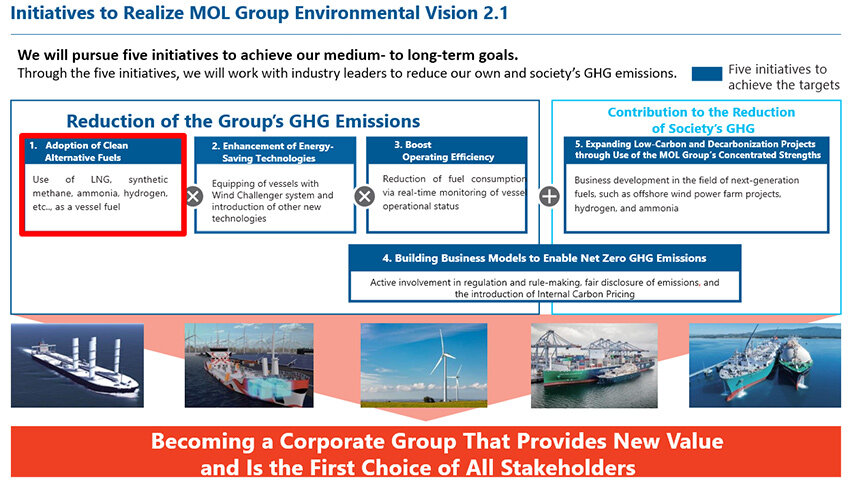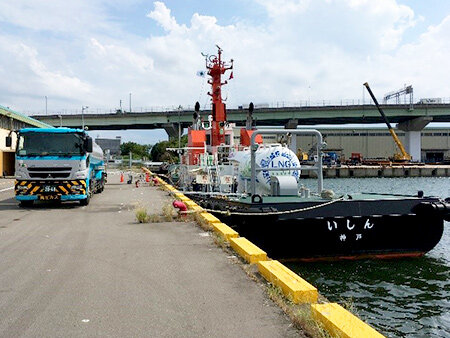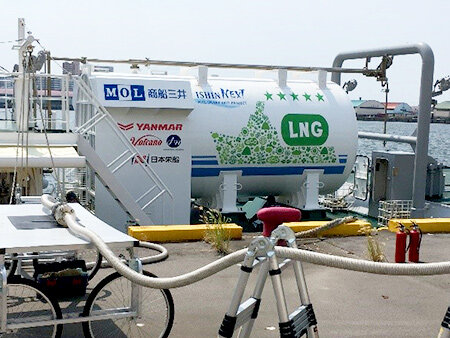- JP
- EN
Japan's First: LNG-fueled Tugboat Ishin Uses Carbon Neutral LNG
September 02, 2021
Mitsui O.S.K. Lines, Ltd. (MOL; President & CEO: Takeshi Hashimoto; Headquarters: Minato-ku, Tokyo) and its group company Nihon Tug-Boat Co., Ltd. (Nihon Tug-Boat; President: Tetsuro Nishio; Headquarters: Chuo-ku, Hyogo Prefecture) today announced that the Nihon Tug-Boat-operated liquefied natural gas (LNG)-fueled tugboat Ishin (Note 1) was supplied for the first time with Carbon Neutral LNG (CNLNG) fuel by Osaka Gas Co., Ltd. (President: Masataka Fujiwara; Headquarters: Chuo-ku, Osaka) and Daigas Energy Co., Ltd. (Daigas Energy; President: Masayuki Inoue; Headquarters: Chuo-ku, Osaka) on September 1, 2021. This marks the first use of CNLNG as vessel fuel in Japan.
CNLNG for the Ishin was supplied to the tugboat using the truck to ship method (Note 2) at the wharf in Sakai Senboku Port, Osaka. The "carbon neutral" designation means that all greenhouse gases (GHGs), generated throughout the life cycle of natural gas extraction, liquefaction, transport, production, and combustion processes, were offset by credit (Note 3), and CNLNG is expected to gain wide adoption in the future for general use as well as vessel fuel (Note 4).
The tugboat Ishin is owned by MOL, and has been operated by Nihon Tug-Boat since February 2019. It has been supplied with LNG fuel from Daigas Energy since the beginning of the operation (Note 5). On this occasion, Daigas Energy and Nihon Tug-Boat signed a memorandum of understanding (MoU) for supply of CNLNG over several years.
Moves to tighten regulations on exhaust emissions from merchant vessels have accelerated in recent years. In April 2018, International Maritime Organization (IMO) adopted an initial strategy on the reduction of GHG emissions from international shipping by at least 50% by 2050 compared to 2008 levels, and to phase out GHG emissions from international shipping as soon as possible, in this century.
The goal of the MOL Group is to achieve net zero GHG emissions by 2050, as set out in the "MOL Group Environmental Vision 2.1" (Note 6), announced in June 2021. The group set the "Adoption of Clean Alternative Fuels" strategy (Fig. 1) to realize the goal, and plans to introduce about 90 LNG-fueled vessels by 2030. The Ishin is MOL's first LNG-fueled vessel, and the group continues its proactive push on new initiatives to reduce GHG emissions.
MOL aims to promote the wider use of LNG-fueled vessels while working to adopt new alternative fuels such as ammonia and conducting research and development on the use of synthetic methane, which is expected to contribute to further GHG reduction. It not only strives to reduce GHG emissions generated from its own operations, but also to meet the needs of customers and society to reduce the environmental impact of its activities.
(Fig. 1)

[ Suppling CNLNG to the LNG-fueled tugboat Ishin ]


[ Outline of Ishin ]
Gross tonnage: 247 tons
Length: 43.6m
Breadth: 9.20m
Draft: 3.15m
Speed: 16.4 knots +
Main engine: Two Yanmar 6EY26DF dual-fuel commercial marine engines
(Note 1)
For details, please refer to the February 28, 2019, press release: MOL Holds Delivery Ceremony for LNG-fueled Tugboat Ishin - Marking Solid Progress toward Start of New Business -
and the July 15, 2020, press release: LNG-fueled Ishin, Sunflower Kurenai and Sunflower Murasaki Earn Top Energy Conservation Rating for Japanese Coastal Ships.
The Ishin's excellent environmental performance-including an estimated 25% reduction in CO2 emissions in comparison to tugs that run on A fuel oil - has the top rating of five stars in the Ministry of Land, Infrastructure, Transport and Tourism's energy-saving rating program for Japan's coastal ships.
(Note 2)
The truck-to-ship LNG bunkering procedure supplies LNG fuel from an LNG truck on shore. For details, please refer to the January 31, 2019, press release: LNG-fueled Tugboat Ishin Marks 1st Bunkering of LNG Fuel in Kansai Region
(Note 3)
Carbon offset credit refers to a tradable form of quantified GHG reduction and absorption, realized by introduction of renewable energy, introduction of energy-efficient equipment, or forest management such as afforestation and tree thinning, into a specific method.
(Note 4)
Treatment of GHG emissions in case of using CNLNG as ship fuel is required to establish rules at IMO, etc.
(Note 5)
Initially, LNG was supplied by OGCTS. On April 1, 2020, Daigas Energy absorbed and merged with OGCTS and succeeded the business.

